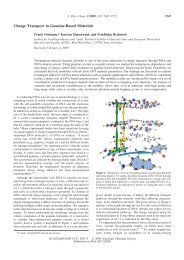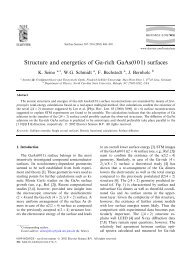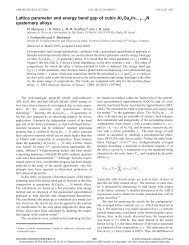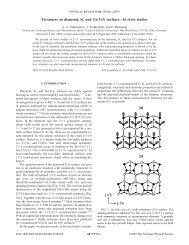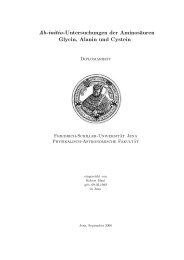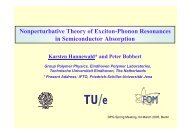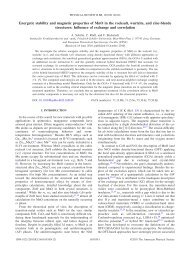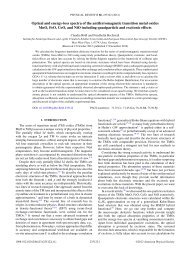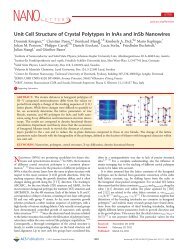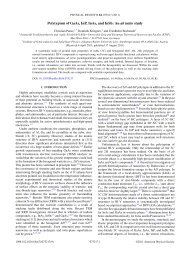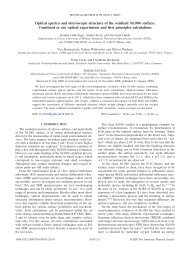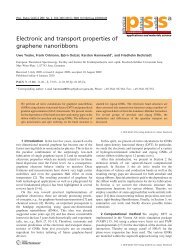Beyond the GW approximation - APS Link Manager - American ...
Beyond the GW approximation - APS Link Manager - American ...
Beyond the GW approximation - APS Link Manager - American ...
You also want an ePaper? Increase the reach of your titles
YUMPU automatically turns print PDFs into web optimized ePapers that Google loves.
ROMANIELLO, BECHSTEDT, AND REINING PHYSICAL REVIEW B 85, 155131 (2012)<br />
matrix. These screened T matrices indeed require appropriate<br />
double counting corrections to keep <strong>the</strong> second-order terms<br />
exact and to avoid negative spectral functions. Therefore,<br />
in <strong>the</strong> following we present a unified framework that links<br />
<strong>GW</strong>, <strong>GW</strong>Ɣ, and T matrix. This allows us to address several<br />
questions, in particular, What is <strong>the</strong> origin of, and link between,<br />
<strong>the</strong> particle-particle and <strong>the</strong> electron-hole contributions to <strong>the</strong><br />
T matrix? How do we get a screened version of <strong>the</strong> T matrix?<br />
How do we translate <strong>the</strong> physical content of <strong>the</strong> T matrix into a<br />
vertex correction? These questions will be answered in Sec. II.<br />
In Sec. III we will <strong>the</strong>n apply <strong>the</strong> T matrix to <strong>the</strong> Hubbard<br />
molecule at 1/4 and 1/2 filling. This system allows us to<br />
compare <strong>the</strong> T matrix, <strong>GW</strong>, and <strong>the</strong> exact results, and, hence,<br />
to illustrate <strong>the</strong> performances of <strong>the</strong> different <strong>approximation</strong>s.<br />
Conclusions are given in Sec. IV.<br />
II. A UNIFIED FRAMEWORK<br />
In order to use a common language for <strong>GW</strong>Ɣ and T<br />
matrix, we start from <strong>the</strong> following exact expression for <strong>the</strong><br />
self-energy:<br />
(11 ′ ) =−iv c (1 + 2)G 2 (12; 32 + )G −1 (31 ′ ), (1)<br />
where (1) = (r 1 ,σ 1 ,t 1 ), (1 + ) = (r 1 ,σ 1 ,t + 1 ) with t + 1<br />
= t 1 + δ<br />
(δ → 0 + ) describe space, spin, and time coordinates, and<br />
integration over indices not present on <strong>the</strong> left is implicit<br />
throughout <strong>the</strong> paper. By adding a perturbing potential<br />
U ext and using <strong>the</strong> relation G 2 (12; 32 + ;[U ext ])| Uext =0 =<br />
G(13)G(22 + ) − δG(13)<br />
δU ext (2) | U ext =0, 40 Eq. (1) can be written as<br />
(11 ′ ) = v H (1)δ(11 ′ ) − iv c (1 + 2)G(13) δG−1 (31 ′ )<br />
∣ , (2)<br />
δU ext (2)<br />
δG<br />
δU ext<br />
∣<br />
Uext =0<br />
where =−G δG−1<br />
δU ext<br />
G is used. Here v H (1) =<br />
−iv(1 + 2)G(22 + ) is <strong>the</strong> Hartree potential and <strong>the</strong> second<br />
term on <strong>the</strong> right-hand side defines <strong>the</strong> exchange-correlation<br />
contribution to <strong>the</strong> self-energy, xc . With <strong>the</strong> help of <strong>the</strong><br />
Dyson equation for G, Eq.(2) can be fur<strong>the</strong>r rearranged as<br />
(11 ′ ) = v H (1)δ(11 ′ ) + x (11 ′ ) + iv c (1 + 2)<br />
× G(13)(35; 1 ′ 4)L(42; 52 + ), (3)<br />
with x (11 ′ ) = iv(1 + 1 ′ )G(11 ′ ), (35; 1 ′ 4) = δ(31′ )<br />
<strong>the</strong> effective<br />
interaction, and L(42; 52) = δG(45)<br />
δU ext (2) | U ext =0 <strong>the</strong> time-<br />
δG(45)<br />
ordered “response” of <strong>the</strong> system to an external perturbation<br />
U ext . This way of writing <strong>the</strong> self-energy directly displays <strong>the</strong><br />
physics behind it, i.e., <strong>the</strong> description of a particle interacting<br />
with <strong>the</strong> system: The particle can scatter against <strong>the</strong> density of<br />
<strong>the</strong> system (Hartree term), it can exchange with ano<strong>the</strong>r particle<br />
of <strong>the</strong> system (exchange term), and it can do something to <strong>the</strong><br />
system (last term), i.e., it can have an effective interaction with<br />
<strong>the</strong> system (), <strong>the</strong> system responds (L), and <strong>the</strong> particle feels<br />
this response through <strong>the</strong> Coulomb interaction (v c ).<br />
There are two essential ingredients in Eq. (3): The effective<br />
interaction (35; 1 ′ 4) and <strong>the</strong> response of <strong>the</strong> system<br />
L(42; 52). Combining <strong>approximation</strong>s to and to L, various<br />
<strong>approximation</strong>s to <strong>the</strong> self-energy can be created. In situations<br />
where <strong>the</strong> screening is important, one should make an effort<br />
to obtain a good L, whereas in situations where <strong>the</strong> quantum<br />
nature of <strong>the</strong> interaction is important, 41 one would concentrate<br />
on , although L and are, of course, in principle, linked<br />
through <strong>the</strong> Be<strong>the</strong>-Salpeter equation 33 and one might wish to<br />
keep <strong>the</strong>m approximately consistent.<br />
A. How to get <strong>GW</strong><br />
Neglecting <strong>the</strong> variation of xc in , i.e., keeping only<br />
<strong>the</strong> classical interaction v c , one obtains xc (11 ′ ) = x +<br />
iv c (12)G(11 ′ )v c (1 ′ 4)χ(42), with χ(42) =−iL(42; 42) <strong>the</strong><br />
time-ordered response function. Hence, one gets a screening<br />
contribution with respect to x : This is <strong>the</strong> <strong>GW</strong> form, with<br />
W = v c + v c χv c . At this stage it has not been specified yet<br />
how to calculate <strong>the</strong> screening: Different <strong>approximation</strong>s<br />
to <strong>the</strong> screening will give <strong>the</strong> various <strong>GW</strong> flavors (e.g.,<br />
<strong>GW</strong> RPA , with W within <strong>the</strong> random-phase <strong>approximation</strong>, and<br />
beyond). 42 If one keeps an approximate xc in one goes<br />
beyond <strong>GW</strong> and includes vertex corrections. For example,<br />
approximating xc by <strong>the</strong> exchange-correlation potential of<br />
DFT, v xc , one gets xc (11 ′ ) = x + iv c (12)G(11 ′ )[v c (1 ′ 4) +<br />
f xc (1 ′ 4)]χ(42), where f xc = δv xc<br />
δρ ; this leads to xc = i<strong>GW</strong>Ɣ<br />
with an approximate vertex function Ɣ = 1 + f xc P , where<br />
P = iGGƔ is <strong>the</strong> irreducible polarizability and we used<br />
χ = P + Pv c χ. 43 B. How to get <strong>the</strong> T matrix<br />
One could also use <strong>the</strong> rough <strong>approximation</strong> L(42; 52) =<br />
−G(47) δG−1 (78)<br />
δU ext<br />
G(85) ≈ G(42)G(25) but concentrate on a<br />
(2)<br />
clever <strong>approximation</strong> for . This modifies <strong>the</strong> exact selfenergy<br />
(3) as<br />
(11 ′ ) ≈ v H (1)δ(11 ′ ) + x (11 ′ ) + iv c (12)<br />
[ δ(31 ′ ]<br />
)<br />
× G(13)<br />
δG(45) G(42)G(25) . (4)<br />
1. An effective four-point interaction O<br />
An appropriate <strong>approximation</strong> for <strong>the</strong> functional derivative<br />
on <strong>the</strong> right-hand side of Eq. (4) still remains to be found. One<br />
can introduce an effective four-point interaction O such that,<br />
similarly to <strong>GW</strong>,<br />
(11 ′ ) = G(42)O(12; 1 ′ 4). (5)<br />
Note that Eq. (5) is closely related to <strong>the</strong> expression of <strong>the</strong><br />
self-energy within <strong>the</strong> T -matrix <strong>approximation</strong> as given, e.g.,<br />
by Kadanoff and Baym [see Eq. (56) in Ref. 17], which is <strong>the</strong><br />
goal of this derivation. However, at this stage, O is not yet <strong>the</strong><br />
T matrix. Since G(42)O(12; 1 ′ 4) cannot be inverted to find<br />
O, several choices of O make <strong>the</strong> correct . 44 First, note that<br />
in Eq. (4) <strong>the</strong>re are direct and exchange terms. Therefore, it<br />
is convenient to divide <strong>the</strong> self-energy as = 1 + 2 and,<br />
consequently, O = O 1 + O 2 with<br />
O 1 (12; 1 ′ 4) =−iv c (12)δ(11 ′ )δ(42) + iv c (12)<br />
[ δ1 (31 ′ ]<br />
)<br />
× G(13)<br />
δG(45) G(25) , (6)<br />
O 2 (12; 1 ′ 4) = iv c (12)δ(21 ′ )δ(41) + iv c (12)<br />
[ δ2 (31 ′ ]<br />
)<br />
× G(13)<br />
δG(45) G(25) . (7)<br />
155131-2



